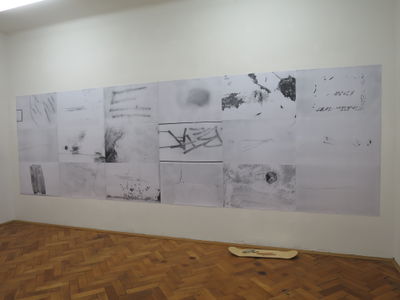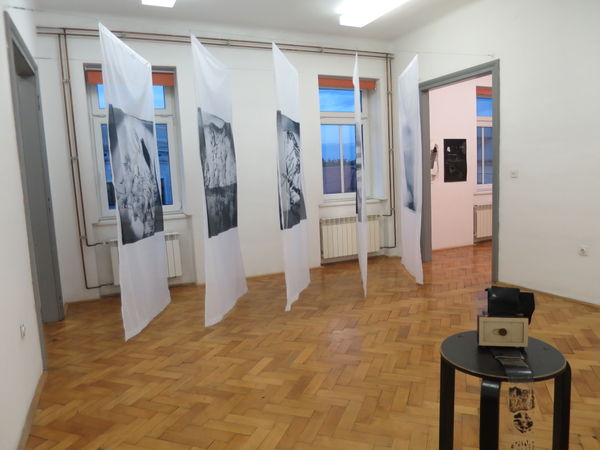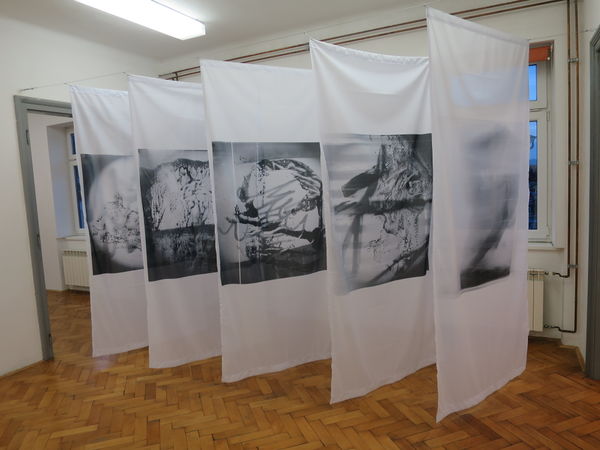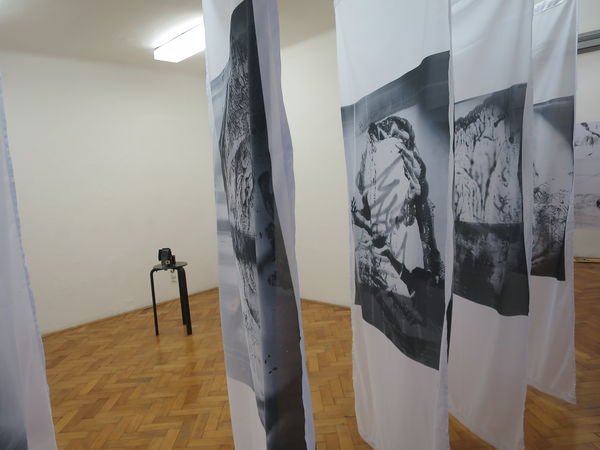Mia/Project proposal: Difference between revisions
No edit summary |
|||
| Line 102: | Line 102: | ||
7. relation to the larger context | 7. relation to the larger context | ||
*History of photography (early-photographic processes) | |||
*Theories of drawing (drawing in a broad sense) | |||
*Theory of the photographic medium (V. Flusser, S. Sontag, M. Jay) | |||
*Related practices: http://pzwiki.wdka.nl/mediadesign/Mia/References | |||
*e.g.: Claude Blo Ricci, Tacita Dean, Pierre Cordier, Nadezda Nikolova-Kratzer, Juliana Borinski, Peter Rauch… | |||
8. references | 8. references | ||
TBD | TBD | ||
Revision as of 08:04, 9 October 2019
Project proposal DRAFT 1 (12.9. 2019)
1. What do you want to make? And how?
- I wish to continue with the practice between photography and gestural mark making (including both 'Trace' and 'Drawing Camera')
- concretely: I propose to make a photographic series (pictures that merge photographs and drawings), possibly an installation
- to continue 'Trace' – photographic series, a typology (of marks of use, deliberate or accidental traces in public space). HOW: By making more books and explore other means of presentation (wallpaper, flooring etc.)
- to further develop the 'Drawing Camera'. HOW: By making another camera (to explore possibilities of movement integrated in the pictures); taking more pictures; trying out different means of materialisation of the photographs (on support such as textile, plexiglass, paper etc.)
- Photograms and camera-less pictures. HOW: Create in the darkroom.
3. What is your timetable?
- September&October: printing, materialising the pictures I made in the past trimester
- October&November: 2 exhibitions (to try out a couple of ideas, as prototypes)
- October: making another camera
- December: darkroom experimentation
- Then … I don’t know yet
4. Why do you want to make it?
With my recent practice, I explore mark-making between photography and drawing because it seems to me that there are fundamental similarities between the marks we leave in general. I believe this kind of traces are something we all have in common. They are in fact predecessors of (visual and verbal) language and belong to the very human nature which fascinates me. I am attracted to the fundamentals of both means of image-making, photographic and gestual and I think they are tightly related. In fact, in the early stages of photography (which is a much younger medium than drawing and painting), similarities between them were much more obvious and visible. On the one hand, photographers were trained with a painter's eye and on the other, painters would adopt photographic understanding of flattened space. The relation was thus reciprocal, sharing principles in composition, methodology, colour, understanding of space etc. With the development of (digital) photography, the latter seems to differ from hand-made gestual image-making and I wish to bring attention to the principles they still share.
5. Who can help you and how?
- Tutors: analyzing, bringing another view on what the work means
- Fellow students: same
- Sonia as an experienced photographer, also interested in formal and inherent qualities of the photographic medium: by sharing the research (group readings), *practical experiences and skills (help with printing in the darkroom)
- Mathijs (guest teacher for DIY camera workshop): building another camera
- Teachers of the photography workshop (Menno and Jeroen): practical and technical matters (actual printing, building the camera etc.)
6. Relation to previous practice
- Previous practice based in drawing, painting, printmaking
- Current practice means bridging these with photography
- All share the basic concepts such as: a mark, an image, an index, a print, a gesture, surface and layering
7. Relation to a larger context
- History of photography (early-photographic processes)
- Theories of drawing (drawing in a broad sense)
- Theory of the photographic medium (V. Flusser, S. Sontag, M. Jay)
- Related practices: http://pzwiki.wdka.nl/mediadesign/Mia/References
- e.g.: Claude Blo Ricci, Tacita Dean, Pierre Cordier, Nadezda Nikolova-Kratzer, Juliana Borinski, Peter Rauch…
8. References
- TBD
Project proposal DRAFT 2 (8.10. 2019)
1. & 2. what do you want to make and how?
I wish to continue with my practice between photography and gestural mark making by further development of 'Trace' and 'Drawing Camera', projects that I came up with last year and would like to build from in the following months.
I propose to make a photographic series consisting of pictures that merge photographic and drawing principles. Currently, I regard the series (which has its first elements already from the past year) as a starting point rather than the end result. The final form the practice could take for the graduation show is not limited to the pictures hanging on the walls, but could be an object, a spatial installation, or a moving image piece.
On the one hand, I am continuing with 'Trace', which began as a photobook, a collection of marks of use, deliberate or accidental traces in public space. It is a photographic series, exploring drawing or painterly fragments (both intentional and accidental) in my everyday environment. I wish to enrich this typology of traces by taking more pictures, analysing and grouping them and finally to experiment with different means of presentation. As photobook turned out quite interesting, I am planning to make more, possibly inversed in colour (black book placed on white chalk powder). I also wish to try out the form of the flooring, where people could walk over the photographs and inevitably leave actual traces. Thinking about the flooring led me to try it out with the wallpaper, which is (was) on show in a gallery Hiša culture v Pivki (Slovenia). See my wiki on that here
→ PROTOTYPE
When designing the wallpaper, I decided for a blow-up of my 35 mm analogue photographs to the size of 90x57 cm. What I like about this magnification is that fragments of reality that usually remain unnoticed, acquired the status of important images and are thus asking for viewer’s attention and analysis. Secondly, the gesture means a transfer from public (urban) environment to the interior (closed) gallery space, which was, in this case in a rather rural region of Slovenia. However, in the exhibition I realised I should pay more attention to the kind of print I make (quality, contrast etc.) and that I need to use the material strong enough to be glued with wallpaper glue, as I want the photographs to really become a part of the exhibition wall (which was not the case as they were wall-mounted on several spots instead of all over the surface).
On the other hand, I am exploring the relation between photographic and hand-made gesture through my hand-made Drawing Camera. Basic principle of the camera is merging the photograph with a hand-made drawing, which is made possible by the plastic foil, carrying the gestural marks, inserted in the camera body. Then the picture is taken, resulting in a layering or a ‘collage’, made in the machine itself and not afterwards in the darkroom or post-production. In the past year, I produced a few dozens of such pictures and next step is to print them and give them some physical body and support.
→ PROTOTYPE
While thinking about the material to embody the images, I got fascinated by large scale prints on fabric and paper that I saw in Witte de With Centre for Contemporary Art at the exhibition of Rosella Biscotti. I could imagine my pictures to be printed on translucent fabric or semi-transparent paper (such as washi or tracing paper). Mainly because transparencies are already inherent in these pictures (plastic foil, shots through the glass etc.), I wanted to pronounce (or tautologically repeat) this layering with the material they are printed on. I ordered five prints on 115g polyester (commercially used for flags), as it is slightly seen through and the prints are almost equally visible from both sides. For the exhibition in Pivka, I decided to make a corridor connecting two entries of the room, in a way that images overlap, and the viewer has an inkling of the images behind the front one. I found this spatial arrangement beneficial, as the visitors had to actively observe the work by moving around and through it, discovering it layer by layer.
- (photos: Leon Zuodar)
The next step in this exploration is different materialisations of existing images. I wish to try out a few more supports and printing techniques (both digital and analogue) to be able to compare and think about the connotations they carry. I am interested in textiles, papers and plexiglass to name a few. I am also planning to take more pictures while being more precise on the subject (whether it is something concrete that deals with marks, an index as a proof of a specific incident, a landscape, or whether the medium itself is a subject, which results in rather abstract pictures I have made so far). I am considering participating in the EYE project and turn my pictures into a moving image piece (but the idea is still too vague to describe). As an addition to the above described path, I would like to experiment in the darkroom with making some photograms and camera-less photography which I understand as a direct link between photographic and gestural image-making.
3. what is your timetable?
- September&October: printing, materialising the pictures I made in the past trimester
- October&November: 2 exhibitions (Pivka and Kranj - to try out a couple of ideas, as prototypes)
- November: making another photobook
- until December: darkroom experimentation
- December and January: EYE project (moving image)
- Then … I don’t know yet
4. why do you want to make it?
With my recent practice, I explore mark-making between photography and drawing because it seems to me that there are fundamental similarities between the marks we leave in general. I believe this kind of traces are something we all have in common. They are in fact predecessors of (visual and verbal) language and belong to the very human nature which fascinates me. I am attracted to the fundamentals of both means of image-making, photographic and gestual and I think they are tightly related. In fact, in the early stages of photography (which is a much younger medium than drawing and painting), similarities between them were much more obvious and visible. On the one hand, photographers were trained with a painter's eye and on the other, painters would adopt photographic understanding of flattened space. The relation was thus reciprocal, sharing principles in composition, methodology, colour, understanding of space etc. With the development of (digital) photography, the latter seems to differ from hand-made gestual image-making and I wish to bring attention to the principles they still share.
5. Who can help you and how?
- Tutors: analyzing, bringing another view on what the work means
- Fellow students: same
- Sonia as an experienced photographer, also interested in formal and inherent qualities of the photographic medium: by sharing the research (group readings), *practical experiences and skills (help with printing in the darkroom)
- Mathijs (guest teacher for DIY camera workshop): building another camera
- Teachers of the photography workshop (Menno and Jeroen): practical and technical matters (actual printing, building the camera etc.)
6. Relation to previous practice
My background is strongly rooted in drawing, painting and printmaking, and I actually do not have much experience in photography. I was mainly interested in the formal ascpects of the medium in combination with appropriated or recycled imagery, resulting in collage or mixed-media works with abstraction as an important mechanism. But since I feel that especially analogue photography is in many ways similar or shares some principles with hand image-making, I regard it as a natural continuation of my practice. Of course by saying photography I am mostly focused on analogue or even early photographic processes. My exploration of these is centered around the same fundamental concepts as my previous practice - what is a mark, an index, a print, what is a gesture, surface and layering. This results in the formal characteristics of the recent works being similar to the older ones - mainly abstract imagery with gesture, texture and surface being very pronounced.
7. relation to the larger context
- History of photography (early-photographic processes)
- Theories of drawing (drawing in a broad sense)
- Theory of the photographic medium (V. Flusser, S. Sontag, M. Jay)
- Related practices: http://pzwiki.wdka.nl/mediadesign/Mia/References
- e.g.: Claude Blo Ricci, Tacita Dean, Pierre Cordier, Nadezda Nikolova-Kratzer, Juliana Borinski, Peter Rauch…
8. references TBD




